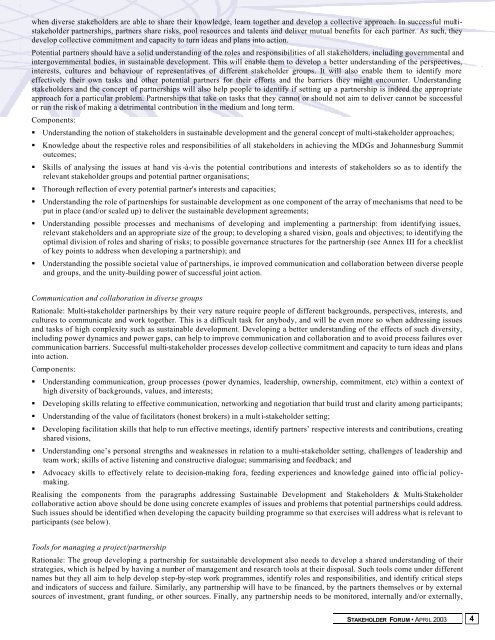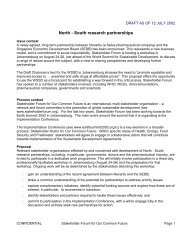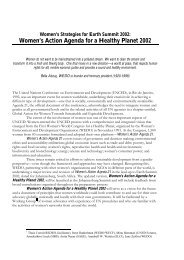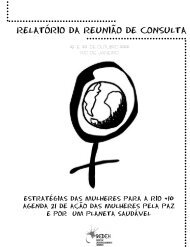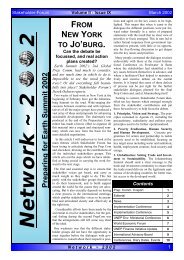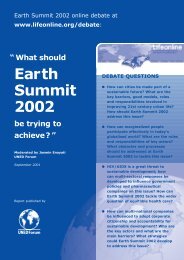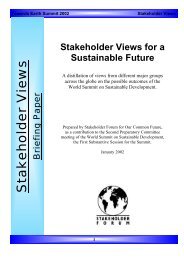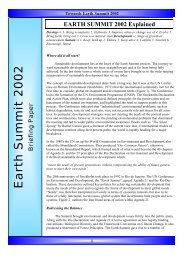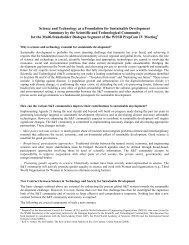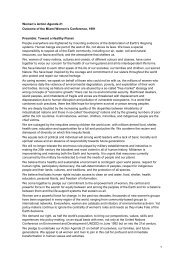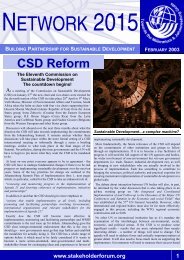Capacity Building for Partnerships - Earth Summit 2002
Capacity Building for Partnerships - Earth Summit 2002
Capacity Building for Partnerships - Earth Summit 2002
Create successful ePaper yourself
Turn your PDF publications into a flip-book with our unique Google optimized e-Paper software.
when diverse stakeholders are able to share their knowledge, learn together and develop a collective approach. In successful multistakeholderpartnerships, partners share risks, pool resources and talents and deliver mutual benefits <strong>for</strong> each partner. As such, theydevelop collective commitment and capacity to turn ideas and plans into action.Potential partners should have a solid understanding of the roles and responsibilities of all stakeholders, including governmental andintergovernmental bodies, in sustainable development. This will enable them to develop a better understanding of the perspectives,interests, cultures and behaviour of representatives of different stakeholder groups. It will also enable them to identify moreeffectively their own tasks and other potential partners <strong>for</strong> their ef<strong>for</strong>ts and the barriers they might encounter. Understandingstakeholders and the concept of partnerships will also help people to identify if setting up a partnership is indeed the appropriateapproach <strong>for</strong> a particular problem. <strong>Partnerships</strong> that take on tasks that they cannot or should not aim to deliver cannot be successfulor run the risk of making a detrimental contribution in the medium and long term.Components:• Understanding the notion of stakeholders in sustainable development and the general concept of multi-stakeholder approaches;• Knowledge about the respective roles and responsibilities of all stakeholders in achieving the MDGs and Johannesburg <strong>Summit</strong>outcomes;• Skills of analysing the issues at hand vis -à-vis the potential contributions and interests of stakeholders so as to identify therelevant stakeholder groups and potential partner organisations;• Thorough reflection of every potential partner's interests and capacities;• Understanding the role of partnerships <strong>for</strong> sustainable development as one component of the array of mechanisms that need to beput in place (and/or scaled up) to deliver the sustainable development agreements;• Understanding possible processes and mechanisms of developing and implementing a partnership: from identifying issues,relevant stakeholders and an appropriate size of the group; to developing a shared vision, goals and objectives; to identifying theoptimal division of roles and sharing of risks; to possible governance structures <strong>for</strong> the partnership (see Annex III <strong>for</strong> a checklistof key points to address when developing a partnership); and• Understanding the possible societal value of partnerships, ie improved communication and collaboration between diverse peopleand groups, and the unity-building power of successful joint action.Communication and collaboration in diverse groupsRationale: Multi-stakeholder partnerships by their very nature require people of different backgrounds, perspectives, interests, andcultures to communicate and work together. This is a difficult task <strong>for</strong> anybody, and will be even more so when addressing issuesand tasks of high complexity such as sustainable development. Developing a better understanding of the effects of such diversity,including power dynamics and power gaps, can help to improve communication and collaboration and to avoid process failures overcommunication barriers. Successful multi-stakeholder processes develop collective commitment and capacity to turn ideas and plansinto action.Comp onents:• Understanding communication, group processes (power dynamics, leadership, ownership, commitment, etc) within a context ofhigh diversity of backgrounds, values, and interests;• Developing skills relating to effective communication, networking and negotiation that build trust and clarity among participants;• Understanding of the value of facilitators (honest brokers) in a mult i-stakeholder setting;• Developing facilitation skills that help to run effective meetings, identify partners’ respective interests and contributions, creatingshared visions,• Understanding one’s personal strengths and weaknesses in relation to a multi-stakeholder setting, challenges of leadership andteam work; skills of active listening and constructive dialogue; summarising and feedback; and• Advocacy skills to effectively relate to decision-making <strong>for</strong>a, feeding experiences and knowledge gained into official policymaking.Realising the components from the paragraphs addressing Sustainable Development and Stakeholders & Multi-Stakeholdercollaborative action above should be done using concrete examples of issues and problems that potential partnerships could address.Such issues should be identified when developing the capacity building programme so that exercises will address what is relevant toparticipants (see below).Tools <strong>for</strong> managing a project/partnershipRationale: The group developing a partnership <strong>for</strong> sustainable development also needs to develop a shared understanding of theirstrategies, which is helped by having a number of management and research tools at their disposal. Such tools come under differentnames but they all aim to help develop step-by-step work programmes, identify roles and responsibilities, and identify critical stepsand indicators of success and failure. Similarly, any partnership will have to be financed, by the partners themselves or by externalsources of investment, grant funding, or other sources. Finally, any partnership needs to be monitored, internally and/or externally,STAKEHOLDER FORUM • APRIL 2003 4


